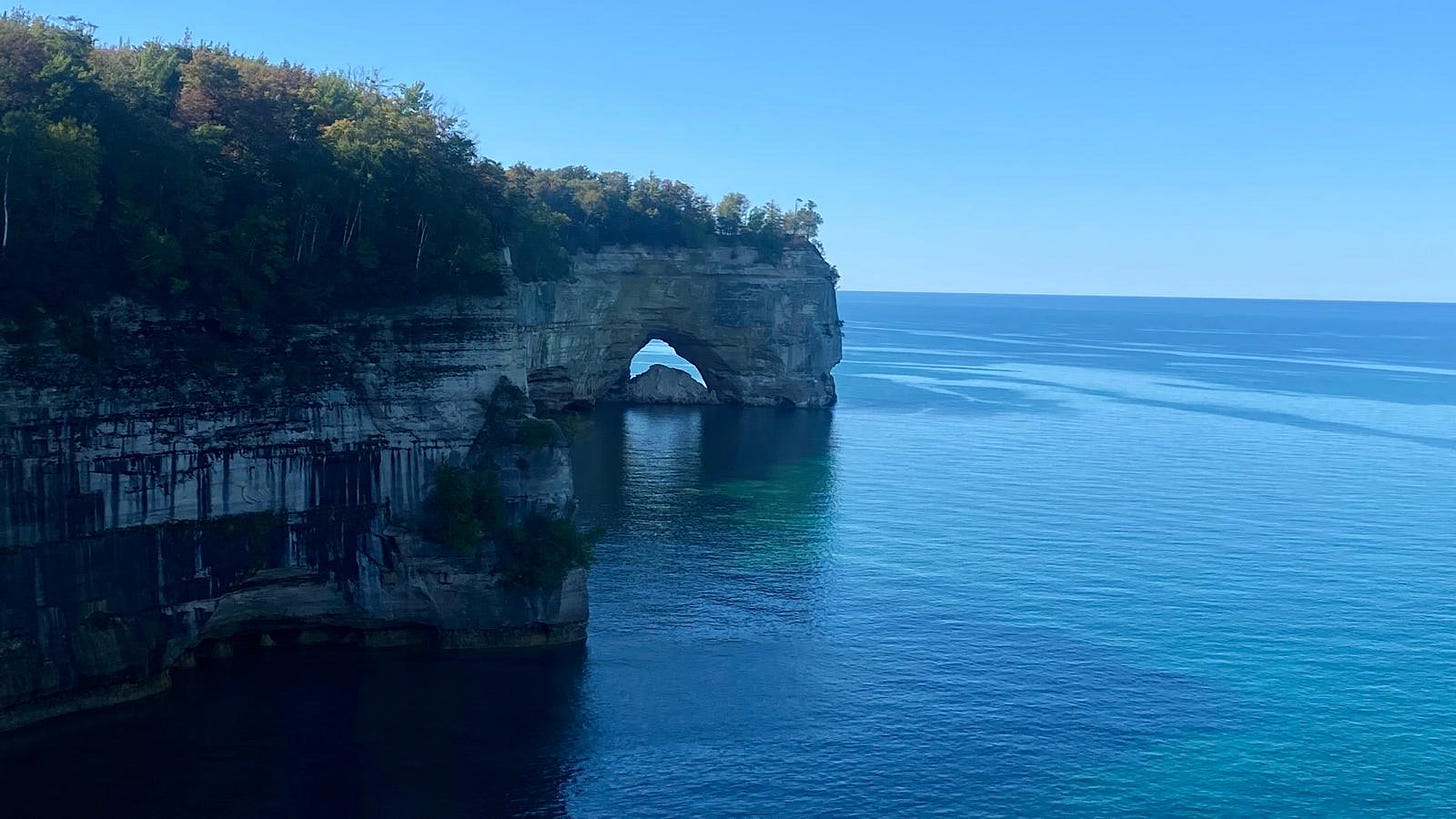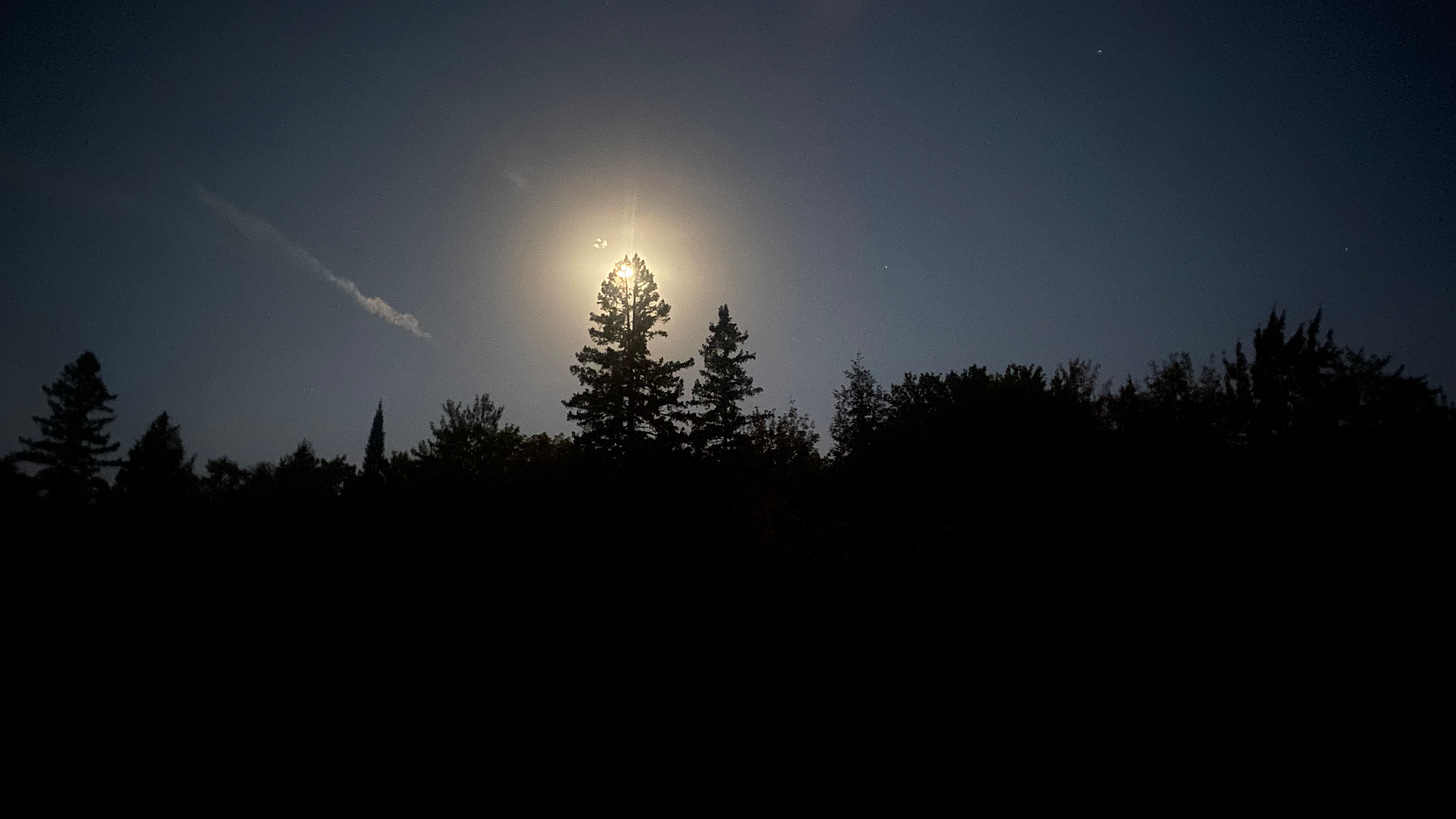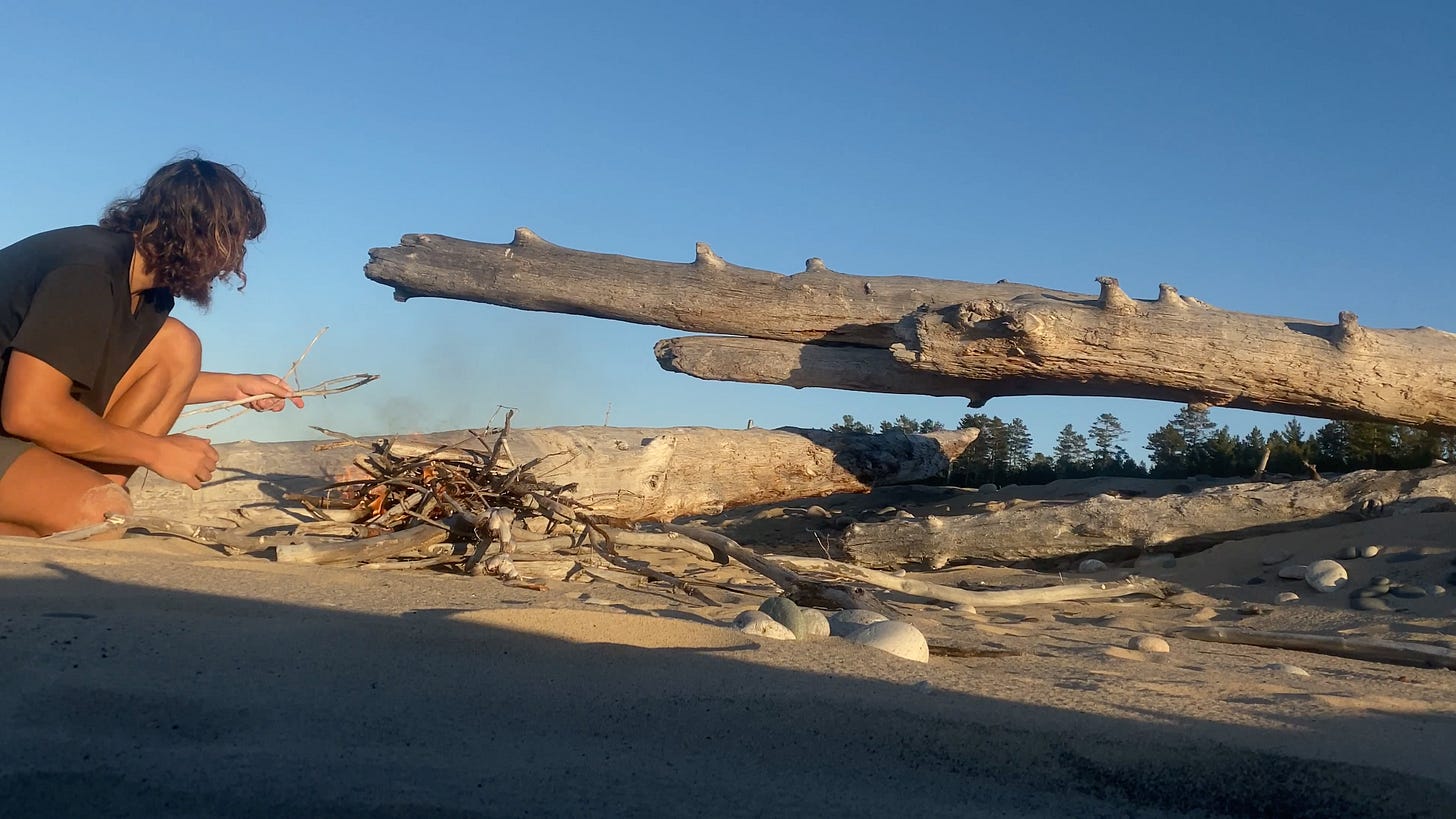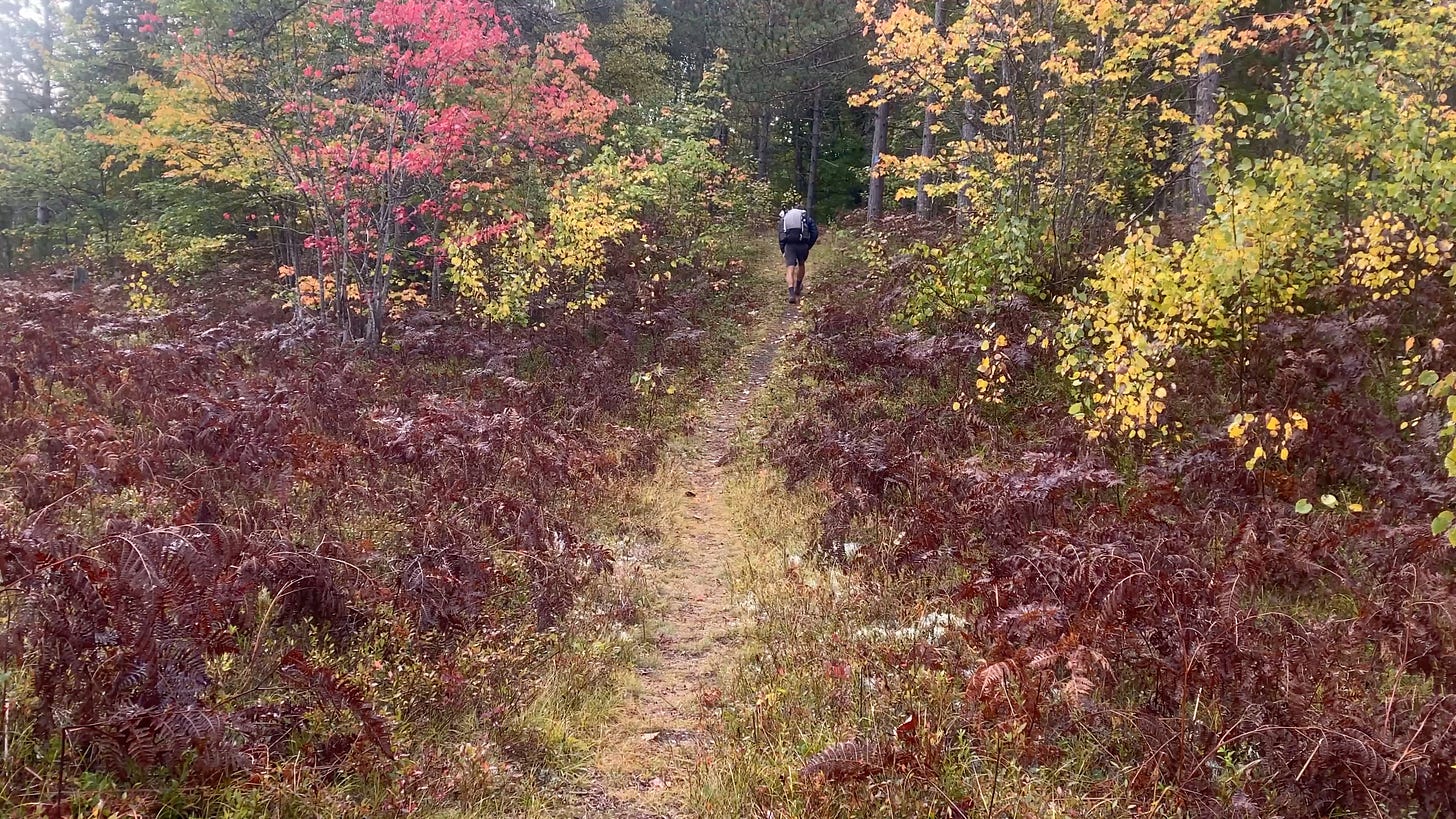The snorting outside my tent no longer startled me. It was just a deer, clearing its nostrils to catch a better scent. They’d been waking me throughout the night.
It was my own fault, really. I had set up camp in a wild orchard, its apples ripe and sweet, practically begging for the Whitetails to come. The deer moved around the orchard's edge, snorting and fussing, keeping me wide awake throughout my first night on the North Country Trail.
I’d seen deer flourish in Southeast Michigan, where I grew up, but I was surprised to find so few signs of them in the northern part of the state. Whether it was wolves, hunters, disease, or something else, they were scarce. In fact, I would have only one more encounter with them during the entire 28 days I spent walking the 615-mile section of trail, from the Michigan-Wisconsin border to my grandmother’s house in Petoskey.
That encounter came near Craig Lake State Park, ten days after my first night in the orchard. I camped just before the park boundary to avoid the hassle of a permit. I found a relatively flat spot near Van Lake, pitched my tent, fastened the screen shut, and left the door open to let in the unseasonably warm air. By nightfall, I was asleep, unaware of the creature that would soon approach.
A soft noise woke me instantly. There he was, standing just outside my tent, looking down at me through the screen. Two thin lines of vapor escaped his nostrils, and his massive rack cast a twisted shadow across my tent.
For a moment, the spikes and steaming nostrils looming above me created a silhouette that was both intimidating and surreal. My heart raced and I froze, breath caught in my chest, feeling his presence above my head.
I hissed at him, like a snake. Later, I would regret it—spooking the buck and robbing myself of the rare privilege of being so close to a wild animal. But in that moment, it was an instinct, not a choice, and in my sleepy confusion, the deer seemed like a threat.
The buck bounded away, barely making a sound beyond the snap of a twig. I let out a slow, shaky breath, counting to four between them, trying to calm my racing heart.
The next morning, I searched for tracks but found none. He had trampled the grass, but there were no split prints, my memory was the only evidence he was real. He was curious, but cautious—wise enough to move through the world with a kind of careful awareness that kept him alive. Judging by the many points on his antlers, he was an older deer, in an environment where most of his kind had vanished.
Though the deer visited me twice on the trail, each time waking me from sleep, the other nights were filled with an almost sacred silence.
I hiked east under the glow of morning stars and the moon. The crunch of a pinecone beneath my foot would echo through the still air. At night, I’d lie awake in my bag, straining to hear something, anything, in the dark. But there was only silence. The towering hardwoods stood like columns in a cathedral, solemn and unmoving.
The forest held its breath.
There were the distant claws of a squirrel, scratching its way up the trunk of a tree, its frantic scramble ending once it reached its desired branch. Settled on a limb, the vigil continued undisturbed.
The only sound that ever broke the stillness was the occasional drop of a pine needle, a faint click as it struck the material of my tent, followed by the light scrape as it slid down the side. It was as if the forest, in its infinite quiet, was showing me how to be still.
There had been no rain during those days, and the region had endured a dry summer as well. The rivers and streams near my campsites were little more than ankle-deep trickles, their slow, silent flow mirroring the stillness of the pine forests above.
When I reached the shores of Lake Superior, that changed. The vastness of the lake, its deep blue waters stretching to the horizon, overwhelmed my senses. I’d been to it before, but on tired feet after a week of walking, it felt more powerful, more alive, than ever before.
I had chosen Michigan because it was where I grew up, yet I had never truly explored it. Though I had seen most of the country and a fair bit of the world, I had never ventured into my own backyard. This journey, this walk along the North Country Trail, was my chance to discover it for the first time.
Lake Superior, even though its features were familiar and its shores well-charted, still held a sense of mystery. It was situated in a largely uninhabited region, untouched by human hands in a way that made it feel like a secret. I was grateful for that. Thank God the soil up here isn’t suited for farming—otherwise, these shores would be polluted with fertilizers, instead of remaining as pristine and wild as they are.

Pictured Rocks National Lakeshore took me along the lake’s colorful cliffs and further east, the trail went down the bluff and crossed the sand and pebble beaches. Walking barefoot on the sand felt good, but the North Country Trail in Upper Michigan was far from just beach walking. I knew the western parts of the trail were rugged, but the terrain still took me by surprise.
The rough surfaces were hard on my feet, tender from months spent paddling in a canoe. I wasn’t in hiking shape, and the jagged trails of the Porcupine Mountains, Huron Mountains, and Trap Hills were grueling. I wasn’t a stranger to long-distance hiking, but my body wasn’t quite ready for this kind of challenge.
I slapped this trip together with just a few days of intense planning as my sore back and sunburnt skin recovered from paddling the length of the Mississippi River with friends.
Walking Michigan was a step back from the suffer fest we willingly endured on the river; it was a slower, quieter journey. The quiet meadows, rugged hills, meditative forests, and peaceful lakeshores were exactly what I needed to unwind and reflect on the summer.
I had everything planned in advance—each meal portioned and packed into boxes that I would pick up along the way. I mailed one box to the office at Tahquamenon Falls State Park and dropped off the rest in person in Rockland, Munising, and Marquette. My brother, from Charlevoix, helped by driving me to the resupply towns along the way and finally to the small bridge over the Montreal River, where my hike began.
Each box held enough food for a steady pace of 22 miles per day. I used downloaded maps, but I also sent hard copies ahead in each box as backups. Though I rarely had to use them, they were cheap insurance. The trail was actually much easier to follow than I had anticipated.
Volunteers had done excellent work marking their rugged sections of the trail, and routing it through some stunning scenery. My favorite in the western region was the expansive vista on top of Bald Mountain, overlooking the Gogebic Range, whose iron ore once brought great wealth to the state.
I navigated through the unmarked McCormick Wilderness and crossed the Mackinac Bridge on the $5 pedestrian shuttle without problems. Both were challenges I had worried about, but in the end, they were no-brainers.
Planning each mile was tedious, but it allowed me to focus entirely on the journey itself. Without the distraction of logistics while I was walking, I could truly immerse myself in my surroundings—the quiet mountains, grey crags, peaceful meadows, and of course, the lake.
Over the 28 days, I touched the shores of three Great Lakes, with Lake Superior dominating most miles until I turned south near Menekaunee Point, heading toward Hiawatha National Forest and the Mackinac Bridge. On the St. Ignace side of the bridge, I found myself walking beside Lake Huron, and further down the trail, I took a side quest from Wilderness State Park to swim in the chilly waves of Lake Michigan.
The maples and birch were beginning to show their autumn hues—rust and gold—as I left the soft sand bluffs of the Superior Shoreline Chapter behind and crossed the Two-Hearted River, entering the dense woodlands of the Hiawatha. A visit to Tahquamenon Falls Brewery with my dad lifted my spirits, and I entered this new territory full of energy.
I remember vividly the love I felt for the region, so much so that I went back to my journal to capture the essence of what I had loved most about it.
Timber sales leave equipment prints and stumps, piles of debris and the powerful scent of pine sap in the air. Between these tracts were the exquisite Upper Michigan colors of autumn. Purple on the ferns as they die out until next summer, green on the conifers, red on the maples, yellow on the birch, white peeling bark and subtle in-between colors of the leaves getting ready to start their death…
I made a fire and built my tent beside the Carp River. It was freezing cold and numbed my muscles to wade in its waters, but I got into the Carp. I went down and soaked in its icy current. My legs stung as the fire brought heat and circulation back to them. The fire is dying down out there as I write this in my tent.
After completing the Hiawatha section and walking the pristinely manicured Harbor Springs Chapter, I finally arrived at my grandmother’s home in Petoskey. I’m close with her and the thought of walking all the way to her house had simmered in the back of my mind since I started doing long walks a couple years ago.
I’m grateful for the opportunity to have finally taken this journey, for all the beautiful miles of the trail that led me to her doorstep. It was quiet out there, the kind of peace you hope for when you step into the forest. At times, it was so still that even the distant honk of a migrating Canadian Goose would startle me, though it would not fly overhead for another couple minutes.
I found that I could think clearly, without distraction, and in those moments of quiet, I found a peace that mirrored the tranquility of the land. My desire to see more of the world remained intact, but the urgency to do it faded.
It struck me one day as I was walking: If I never did another thing—never paddled another river or walked another trail—that would be okay.
The thought came to me like a new, yet familiar feeling—a realization that had been forming quietly in the background. If I never did another thing, that would be okay. It was a mantra in my mind, peaceful and reassuring as I walked away from the place where it had occurred to me.
I’ve walked other long trails, but always as a single, continuous journey from end to end. There’s something different about hiking a section at a time—less pressure, but also a constant curiosity about the miles I haven’t yet explored. This was my first section hike and I liked it.
Returning to my home state to take on this 4,800-mile trail in pieces felt right. I may never have the time to complete the entire trail in one go, but by hiking it in sections, I remain curious about the unhiked miles out there. If I never get to walk those distant miles, that’ll be okay. But I hope this isn’t the end of my story with the NCT.

Jake Redlawski is an adventurer and writer from rural Michigan. He has paddled the Mississippi River, hiked numerous long trails, and spent extensive time adventuing internationally as well. He left a career in interstate truck driving to pursue travel full-time. You can read his stories at StoicNomadic.Substack.com or find him on YouTube @StoicNomadic.








Beautifully written. What a contrast to the journey on the Mississippi that you just came from.
I loved The Quiet Path🇺🇸 I am his grandmother💕